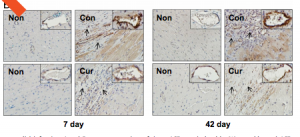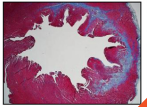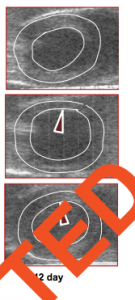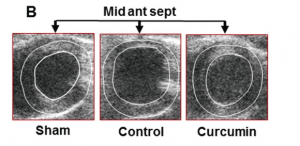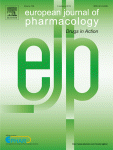 When two papers include the same images of rat hearts, one of those papers gets retracted.
When two papers include the same images of rat hearts, one of those papers gets retracted.
The papers share a corresponding author, Zhi-Qing Zhao of Mercer University School of Medicine in Savannah, Georgia. This marks his third retraction; we reported on two others earlier this year.
The papers examine the effect of curcumin, which has antinflammatory properties (in addition to giving the spice turmeric its yellow color). The retracted paper, “Dual ACE-inhibition and angiotensin II AT1 receptor antagonism with curcumin attenuate maladaptive cardiac repair and improve ventricular systolic function after myocardial infarctionin rat heart,” was published in the January 5, 2015 issue of the European Journal of Pharmacology, and has zero citations, according to Thomson Scientific’s Web of Knowledge. It shares multiple figures with another 2012 paper, “Curcumin promotes cardiac repair and ameliorates cardiac dysfunction following myocardial infarction,” published in the British Journal of Pharmacology, which has not been retracted. The BJP paper has been cited 18 times.
Here’s the retraction note for the EJP paper:
This article has been retracted at the request of the authors, because of publication of questionable figures in the article and in Wang et al., 2012.
1. Figure 2B in Pang et al., 2015, bottom panels “Non, 7 day” and “Non, 42 day” are adjacent sections of the same heart.
Here’s the figure in question:
Next up, from the note:
2. Figure 4 in Pang et al., 2015, panel “Non, Sham” and Figure 3 in Wang et al., 2012, panel “21 day, Sham” are adjacent sections of the same heart.
Here are the panels in question (Pang et al is on the left, Wang et al on the right):
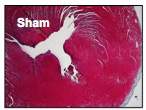

Back to the note:
3. Figure 4 in Pang et al., 2015, panel “42 day, Cur” and Figure 3 in Wang et al., 2012, panel “21 day, Curcumin” show identical pictures.
Here are those pictures, in which it appears one has been flipped:
The note continues:
4. Figure 4 in Pang et al., 2015, right panel, and Figure 7B in Wang et al., 2012 show identical pictures.
Here’s the Pang et al figure:
And the Wang et al figure:
And the last item in the note:
5. The results reported in Pang et al., 2015, were obtained from a proportion of the animals used in Wang et al., 2012, supplemented with a number of new animals, without the authors providing a justification for this.
Based on this the integrity of the results has become doubtful, and the article has been retracted.The authors and the publisher apologize for any inconvenience caused.
We’ve reached out to the editor in chief of BJP, where the original paper was published, and to Zhao. We’ll update this post if we hear back.
Like Retraction Watch? Consider making a tax-deductible contribution to support our growth. You can also follow us on Twitter, like us on Facebook, add us to your RSS reader, and sign up on our homepage for an email every time there’s a new post. Click here to review our Comments Policy.
